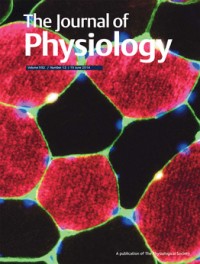Journal of Physiology Q1 Unclaimed
The Journal of Physiology publishes original Research Papers in all areas of physiology and pathophysiology illustrating new physiological principles or mechanisms. Papers on work at the molecular level, cell membrane, single cells, tissues or organs and on systems physiology are all encouraged. We are particularly keen to publish papers that have a clinical or translational focus, to help further our understanding of the role physiology plays in health and disease. It has an SJR impact factor of 1,715.
Journal of Physiology focuses its scope in these topics and keywords: rat, effects, skeletal, calcium, human, protein, alters, blood, current, exercise, ...
Type: Journal
Type of Copyright:
Languages: English
Open Access Policy: Open Choice
Type of publications:
Publication frecuency: -


3292 €
Inmediate OANPD
Embargoed OA0 €
Non OAMetrics
1,715
SJR Impact factor274
H Index638
Total Docs (Last Year)1291
Total Docs (3 years)37205
Total Refs4428
Total Cites (3 years)876
Citable Docs (3 years)3.04
Cites/Doc (2 years)58.32
Ref/DocOther journals with similar parameters
Circulation Q1
Annual Review of Plant Biology Q1
Annual Review of Physiology Q1
Nature Metabolism Q1
Circulation Research Q1
Compare this journals
Aims and Scope
Best articles by citations
Sticky wickets in lower nephron nephrosis
View moreOvine feto-placental metabolism
View moreLeukocytes, cytokines, growth factors and hormones in human skeletal muscle and blood after uphill or downhill running
View moreThe role of carbon monoxide in the gastrointestinal tract
View moreAspartate transporter expression and activity in hypertrophic rat heart and ischaemia-reperfusion injury
View moreThe regulation of normal breathing
View moreThe quantitative estimation of the indophenol oxidase of animal tissues
View moreSpreading dilatation in rat mesenteric arteries associated with calcium-independent endothelial cell hyperpolarization
View moreDevelopmental changes in myoendothelial gap junction mediated vasodilator activity in the rat saphenous artery
View moreNote on "Leech-extract" and its Action on Blood
View moreJust HIT it! A time-efficient exercise strategy to improve muscle insulin sensitivity
View moreModulation of Whole-Cell Currents inPlasmodium Falciparum-Infected Human Red Blood Cells by Holding Potential and Serum
View moreNon-invasive methods for the assessment of brown adipose tissue in humans
View moreNon-specificity of chloride channel blockers in rat cerebral arteries: block of the L-type calcium channel
View moreEffect of intra-articular hyaluronan on pressure-flow relation across synovium in anaesthetized rabbits.
View moreFunctional genomics in rodent models of hypertension
View moreMagnesium-inhibited, TRPM6/7-like channel in cardiac myocytes: permeation of divalent cations and pH-mediated regulation
View moreCorrelation of local and global orientation and spatial frequency tuning in macaque V1
View morePlatelet-Activating Factor: A Previously Unrecognized Mediator of Fever
View moreStimulation-induced changes in lower limb corticomotor excitability during treadmill walking in humans
View moreShort-term adaptive changes in the human vestibulo-ocular reflex arc
View moreThe effect of recombinant human growth hormone and resistance training on IGF-I mRNA expression in the muscles of elderly men
View moreATP participates in three excitatory postsynaptic potentials in the submucous plexus of the guinea pig ileum
View morePlacental vascular endothelial growth factor receptor system mRNA expression in pigs selected for placental efficiency
View more
Comments